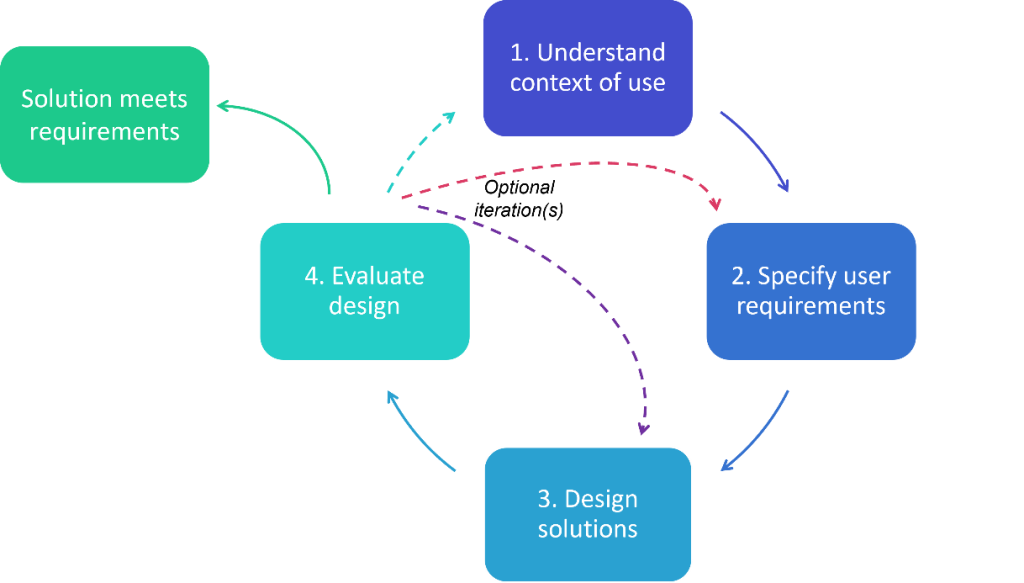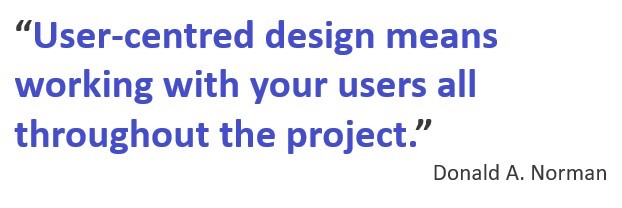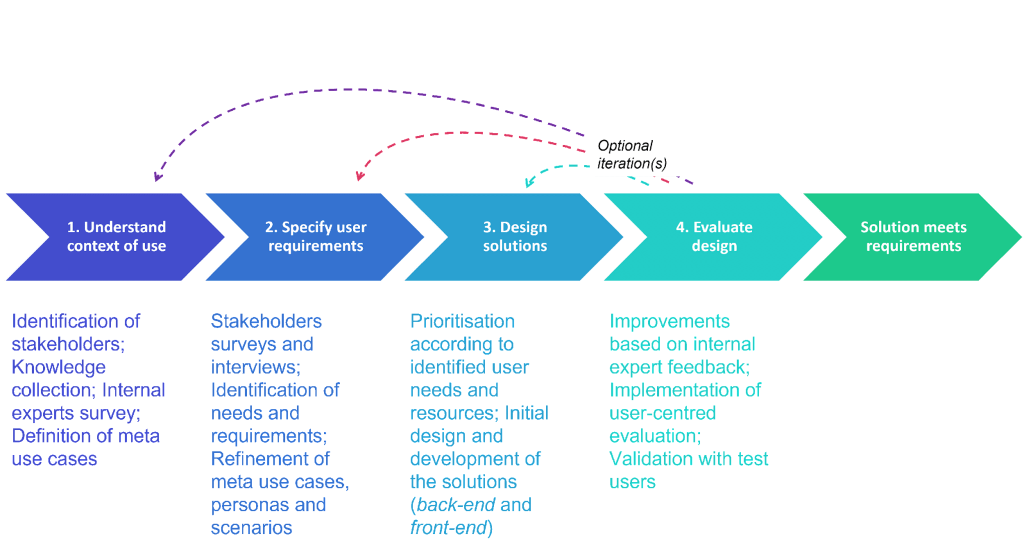
Customer first: BIOMATDB’s user-centric approach drives efforts to create innovative digital solutions
BIOMATDB is developing two innovative digital applications for the biomaterials community: a database and a marketplace. In today’s rapidly evolving digital world, it is essential to understand and prioritise the needs and expectations of end-users to ensure the success of the BIOMATDB solutions.
In this article, we delve into the importance of taking into account the requirements and preferences of customers during the entire design process. We also explore the user-centric approach that the consortium is implementing in order to build two complex systems, so that they are not only functional and efficient, but also valuable and enjoyable for future users.
We live in a fast-paced world where the digital landscape is constantly changing and adapting. According to recent statistics compiled by Forbes, a new website is built every three seconds and there are approximately 1.13 billion of them in 2023 – and counting. However, only 18% of those websites are actively maintained and used. Another astonishing data is that it takes a mere 0.05 seconds for visitors to build their impression of a website [1]. This suggests that it is critical to understand the audience that the digital application is targeting and to integrate this knowledge throughout the design process in order to attract, motivate, convince and retain them. This is where the user-centric approach comes in.
What is human-centred design?
The International Organization for Standardization (ISO) defined human-centred design as “an approach to interactive systems development that aims to make systems usable and useful by focusing on the users, their needs and requirements, and by applying human factors/ergonomics, and usability knowledge and techniques” [2]. In the standard, ISO provides a set of principles and recommendations to ensure that a product meets user needs, the key being to involve the customer from the beginning and to keep them in mind at every stage of the creation process.
In particular, the ISO framework highlights four main steps that should guide the user-centred design process:
● Understand the context of use. This step involves identifying the users and their characteristics, as well as factors such as the user’s tasks, goals, and environment. It also includes gathering information on any constraints or limitations that may impact the design.
● Specify the user requirements. Based on the information gathered in the previous phase, the requirements of the users are defined. This includes their needs, expectations and preferences, as well as any functional and performance requirements.
● Produce design solutions. The generation of potential design solutions appertaining to the user requirements includes creating conceptual designs, prototyping, and testing.
● Evaluate solutions against the user requirements. The design solutions are then evaluated with users to determine how well they meet user requirements. This can consist of usability testing, expert reviews, user feedback and other forms of evaluation.
This process is iterative; based on the feedback received from the users during the evaluation stage, the design solutions are adjusted and refined to ensure that the final product meets the needs and requirements of the users. The active involvement of customers at all stages throughout the design process, and the contribution from a multidisciplinary team that boasts a diversity of skills and perspectives, are therefore at the core of the successful implementation of the human-centred design activities.

Media: The main steps of the human-centred design approach (adapted from ISO, 2010 [3])
The benefits of using a user-centric approach
There are several benefits to taking a user-centric approach when creating the BIOMATDB database and marketplace. First, it helps to ensure that the solutions we are designing meet the needs, requirements, expectations and preferences of the target audience. This can improve customer satisfaction with the final products and increase adoption rates.
Secondly, a user-centric approach can help to enhance the user experience. By empowering the users to share their needs but also their pain points, we can develop unique and creative solutions that align with their behaviour and expectations. This favours the development of products that are easy to use, intuitive, and enjoyable for the customer.
Thirdly, a user-centric approach can help to reduce errors and increase efficiency. By involving users early in the design process, we can identify potential issues and challenges that may arise when using the applications. This can lead to reduced user errors and frustration, which in turn can translate into increased efficiency and productivity.
Finally, a user-centric approach can lead to increased engagement and loyalty. By designing a solution that puts users first, we can help build trust into our solutions. When users feel that their needs are being met and that their feedback is being heard, they are more likely to continue using the solution and recommend it to others.

Media: Quote from Donald Arthur Norman, who introduced the term “user-centred design” in 1986.
How BIOMATDB is applying the user-centric approach
User-centric design takes centre stage in BIOMATDB’s efforts to build a game-changing database and marketplace. At the beginning of the project, a knowledge compilation exercise was performed to collect information on the contextual and environmental aspects relevant to the biomaterials solutions to be developed. This included, for example, data on related biomaterials projects, resources, publications, and products. In conjunction, the consortium defined and identified the five groups of stakeholders that are potential future users of the two core applications: researchers, demanders, suppliers, enablers, and investors/policy makers [4].
Already at the concept stage, the opinion of over 100 of these key biomaterial stakeholders were sought via an online questionnaire, to gather information on their pain points, needs and requirements. In addition, qualitative interviews were performed to improve and better refine the picture already provided by the questionnaire. The results enabled us to establish and prioritise the sources and contents for the first technical concept and design of the solutions. Finally, we made use of an internal survey of the biomaterial experts within the project team to identify any potential new needs and requirements that were not highlighted previously.
Meta-use cases, scenarios and personas for the database and marketplace have been identified based on all the information collected during the knowledge compilation and from the findings of the above-mentioned surveys and interviews. They are currently being used as the starting point for the technical teams to build the solutions. They are incorporated into the design process of both the back-end (selection and treatment of the data that will be used by the users) and the front-end (the interactive interface that the user will use to search and visualise the data) of the applications.
However, it is unlikely that the original design will meet all user wishes and demands. BIOMATDB has therefore dedicated a whole work package to the demonstration and validation of the solutions to be developed in order to ensure that they perform as intended and serve the customers they are destined to. Once the initial design is finalised, a first internal validation will be executed on aspects such as usability, performance, and functionality. The feedback obtained will reveal the strengths and weaknesses of the solutions and bring to the fore potential areas for improvement and refinement of the systems. Appraisals of the suggestions will be made based on the importance of the requirements as well as the technical feasibility of the changes to be implemented.
The second, enhanced version of the database and marketplace will then undergo a series of iterative evaluation and design cycles, that will be based on the feedback gathered from the different external end-user groups. The demonstration and testing will be run by different BIOMATDB partners across Europe to collect inputs about the experience using the applications, the user interface and its functionality. The test users will be recruited through the networks of the BIOMATDB partners, but also by reaching out to the stakeholders identified during the knowledge collection phase. Different tools can be used to gather the feedback of the various users, such as virtual training workshops, webinars, surveys, feedback forms, and interviews. An analysis of the data received from test users will enable the identification of user patterns, feature requests, system bugs, and common issues that will be prioritised for incorporation by the technical teams into the iterative design process to further improve the solutions.

Media: The human-centred design approach taken by BIOMATDB to develop efficient and functional solutions for the end-users.
Overall, implementing a human-centred design approach is crucial for BIOMATDB to develop two complex yet effective and functional applications. It will indeed ensure they meet the needs and address the requirements of the people they are intended to serve, while also providing an opportunity for innovation and differentiation from other tools already available.
If you would like to support the development of the BIOAMTDB database and marketplace and take part in the demonstration and validation of the solutions, do not hesitate to complete our survey [5] or contact us to be enrolled in the upcoming user-testing activities!
Author: Clémence Foltz, Nicole Ticchi, Sauro Vicini
References
[1] Haan, K. (2023). Top Website Statistics For 2023. [online] Forbes Advisor. Available
at: https://www.forbes.com/advisor/business/software/website-statistics/#sources_section
[2] International Organization for
Standardization [ISO] (2019). ISO
9241-210:2019 Ergonomics of human-system interaction — Part 210: Human-centred
design for interactive systems. [online] ISO. Available at: https://www.iso.org/obp/ui/#iso:std:iso:9241:-210:ed-2:v1:en
[3] International Organization for
Standardization [ISO] (2010). ISO
9241-210:2010 Ergonomics of human-system interaction — Part 210: Human-centred
design for interactive systems. [online] ISO. Available at: https://richardcornish.s3.amazonaws.com/static/pdfs/iso-9241-210.pdf
[4] Heinze, V., Rabé, C. (2023). How BIOMATDB will ensure maximum impact of
the project results. [online] BIOMATDB. Available at: https://biomatdb.eu/2023/03/24/how-biomatdb-will-ensure-maximum-impact-of-the-project-results/
[5] BIOMATDB consortium (2022). We want to hear from you! [online]
BIOMATDB. Available at: https://biomatdb.eu/2022/11/03/we-want-to-hear-from-you/